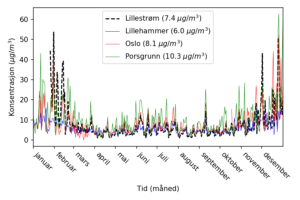The first year of high-quality operative measurements of air pollutants in Lillestrøm, Norway is over and it’s time to judge the air quality in 2021. The overall levels of particles were safe, but high concentrations are monitored during the coldest winter weeks, probably causing problems for vulnerable people. The high levels during winter are mainly due to emissions from residential wood stoves.
About the project
Kjeller Vindteknikk started to perform operative air quality measurements on behalf of Lillestrøm municipality last winter. The measurement station is located in Vollaparken, not far from our head office just east of Oslo. The data for 2021 have been evaluated against National standards and data from other measurement stations.
The measurement station in Vollaparken is monitoring hourly concentrations of particles (PM2.5 and PM10) and NO2 and is defined as an urban background station. This means that the measured data is supposed to represent the air quality over a larger part of Lillestrøm. In Norway, these kinds of stations are normally measuring lower concentrations of air pollution than those located near roads with high traffic loads, particularly for NO2.
Generally good air quality in Lillestrøm
The air quality in Lillestrøm meet the legal requirements to ambient air quality. There are some days when the particle concentrations exceed the levels from the Public Health Recommendations. These recommendations are purely based on health considerations and aim to protect the entire population, also the vulnerable people.
Emission from wood-burning stoves are the most important source contribution to the highest concentration levels measured at the station in Vollaparken. The figures below show the particle concentration (black lines) and the temperatures (blue line) in two periods in 2021 associated with high particle concentrations. There are several signatures showing that wood-stove emissions are the main contributor the particle concentration peaks:
- The PM2.5 is identical to PM10, meaning that fine particles are dominating.
- The concentration peaks are associated with very low temperatures.
- The highest peaks occur in the evening, particularly in the weekends.
The measurement station is located near residential areas with wood stoves.


A comparison with other urban background stations in the eastern part of Norway, shows that the particle concentrations in Lillestrøm are similar or higher than in other cities. The figure below shows the seasonal evolution of concentrations of fine particles (PM2.5) in Lillestrøm, Lillehammer, Oslo and Porsgrunn. While the overall concentrations are low in Lillestrøm, the highest peaks were higher than in the other cities in 2021, particularly during the cold period in January-February.

For more information, please contact Sigmund Guttu sigmund.guttu@norconsult.com and Ola Klaas Eriksen ola.kaas.eriksen@norconsult.com.
You can also find more information here:
